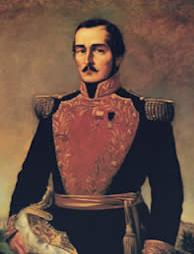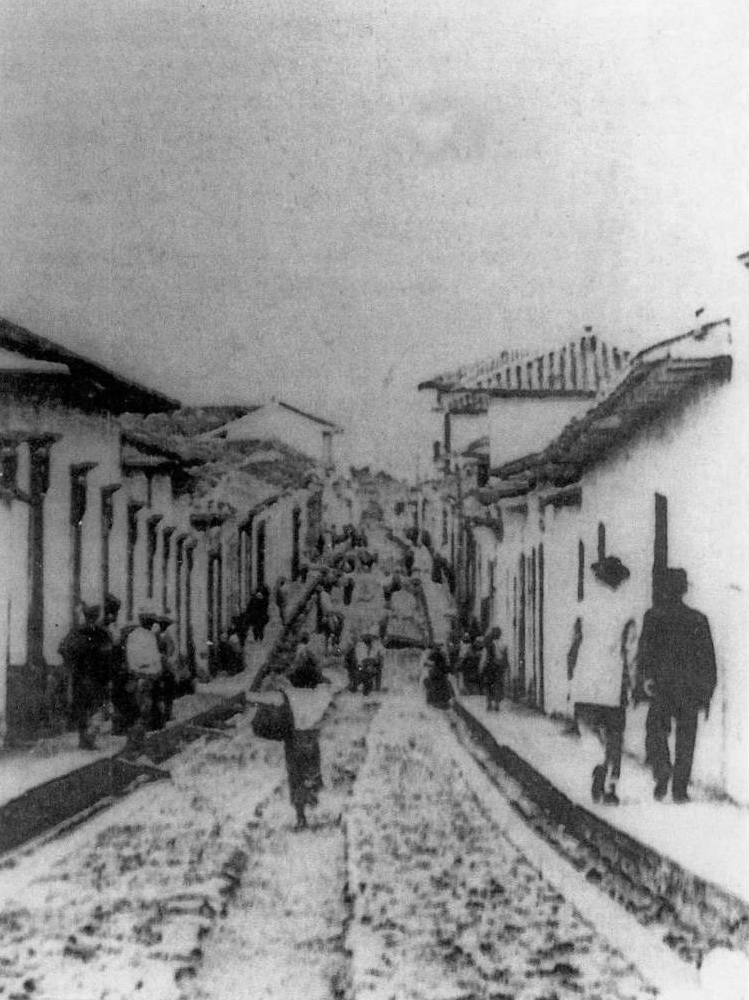|
Battle Of Palonegro
The Battle of Palonegro was a battle in the Santander Department of Colombia, than lasted from May 11—26, 1900, in the early days of the Thousand Days War. The commanding general of the Liberal armies, Gabriel Vargas Santos, ordered his troops to retire to Palonegro, near the city of Bucaramanga in the Santander Department of Colombia. After the battle, the war escalated, and became one of the most brutal conflicts in early 20th century South America. Background After the Liberal victory in the Battle of Peralonso on December 15, 1899, the Liberals could have chosen to march unopposed on the capital, consolidating the defeat of the Conservatives. General Vargas Santos, commander of the Liberal army, believed it was dishonorable to attack the dispersed government army, and ordered that his troops move to Cúcuta, many kilometers from the site of the battle. By the time the General decided to recommence the war in February, fighting off mosquitoes and fever, the new Conser ... [...More Info...] [...Related Items...] OR: [Wikipedia] [Google] [Baidu] |
Thousand Days' War
The Thousand Days' War ( es, Guerra de los Mil Días) was a civil war fought in Colombia from 17 October 1899 to 21 November 1902, at first between the Colombian Liberal Party, Liberal Party and the government led by the National Party (Colombia), National Party, and later – after the Colombian Conservative Party, Conservative Party had ousted the National Party – between the liberals and the conservative government. Caused by the longstanding ideological tug-of-war of federalism versus Unitary state, centralism between the liberals, conservatives, and nationalists of Colombia following the implementation of the Colombian Constitution of 1886, Constitution of 1886 and the political process known as the Regeneración (Colombia), Regeneración (:es:Regeneración (Colombia), es), tensions ran high after the presidential election of 1898, and on 17 October 1899, official insurrection against the national government was announced by members of the Liberal Party in the Department ... [...More Info...] [...Related Items...] OR: [Wikipedia] [Google] [Baidu] |
Ramón González Valencia
Ramón González Valencia (May 24, 1851 – October 3, 1928) was a Colombian conservative, military officer and statesman. He participated in the civil wars of 1876, Colombian Civil War of 1895, and the Thousand Days War.Gobernantes Colombianos, Ignacio Arismendi Posada, Interprint Editors Ltd., Italgraf, Segunda Edición, Page 155, Bogotá, Colombia, 1983 Biographic data González Valencia was born in the town of Chitagá, Norte de Santander Department, on May 24, 1851. He died in the city of Pamplona, Norte de Santander Department, on October 3, 1928.Gobernantes Colombianos, Ignacio Arismendi Posada, Interprint Editors Ltd., Italgraf, Segunda Edición, Page 158, Bogotá, Colombia, 1983 Military career Although González Valencia was a young farmer, working in agriculture and cattle rising, he enlisted in the military during the civil wars of the time. His military career began in 1876, at the battle of ''“Hatogrande”'', the conservative revolt against President Aquil ... [...More Info...] [...Related Items...] OR: [Wikipedia] [Google] [Baidu] |
Batalla De Palonegro Military Historical Museum
Batalla is a Spanish word, meaning "battle". It is also used as a surname (that originated in Spain as well). Notable people with the surname include: * Francesc Badia Batalla (1923–2020), Andorran public servant * Hugo Batalla (1926–1998), Uruguayan politician, Vice President 1995–98 * Pablo Batalla (born 1984), Turkish football player * Perla Batalla, Mexican-American singer-songwriter * Rick Batalla (born 1962), actor and playwright Other * Battaglia (music), musical depictions of battle cultivated in Spain chiefly as a keyboard genre by organist-composers. See also * Un Paso Mas En La Batalla, studio album by V8 {{surname es:Batalla ... [...More Info...] [...Related Items...] OR: [Wikipedia] [Google] [Baidu] |
Ossuary
An ossuary is a chest, box, building, well, or site made to serve as the final resting place of human skeletal remains. They are frequently used where burial space is scarce. A body is first buried in a temporary grave, then after some years the skeletal remains are removed and placed in an ossuary ("os" is "bone" in Latin). The greatly reduced space taken up by an ossuary means that it is possible to store the remains of many more people in a single tomb than in coffins. Persian ossuaries In Persia, the Zoroastrians used a deep well for this function from the earliest times (c. 3,000 years ago) and called it '' astudan'' (literally, "the place for the bones"). There are many rituals and regulations in the Zoroastrian faith concerning the ''astudans''. Jewish ossuaries During the Second Temple period, Jewish burial customs were varied, differing based on class and belief. For the wealthy, one option available included primary burials in burial caves, followed by secondary buri ... [...More Info...] [...Related Items...] OR: [Wikipedia] [Google] [Baidu] |
Cúcuta
Cúcuta (), officially San José de Cúcuta, is a Colombian municipality, capital of the department of Norte de Santander and nucleus of the Metropolitan Area of Cúcuta. The city is located in the homonymous valley, at the foot of the Eastern Ranges of the Colombian Andes, on the border with Venezuela. It comprises an area of approximately 1119 km2, with an urban area of 64 km2 (divided into 10 communes) and a rural area of 1055 km2 (divided into 10 townships). The city has a population of 777,106 inhabitants, which makes it the most populous municipality in the department and the sixth most populous municipality in the country. Similarly, its metropolitan area (made up of the municipalities of Villa del Rosario, Los Patios, El Zulia, San Cayetano and Puerto Santander) has an approximate population of 1,046,347. The city was founded as a parish on June 17, 1733, by Juana Rangel de Cuéllar, resident of Pamplona in the area under the name of ''San José de Guasimales'', as ... [...More Info...] [...Related Items...] OR: [Wikipedia] [Google] [Baidu] |
Battle Of Peralonso
The Battle of Peralonso ( es, Batalla de Peralonso), also known as the Battle of La Amarilla or the Battle of La Laja, was a major battle in the Santander Campaign of the Thousand Days' War in Colombia. It was fought between the Conservative government and the Liberal rebels between 15 and 16 December 1899, ending in an important Colombian Liberal Party, Liberal victory. The Liberal rebels had suffered a series of major defeats culminating in the failed Battle of Bucaramanga (1899), attack on Bucaramanga on 13 November. Afterward, the Liberal forces splintered into three autonomous forces, led by Rafael Uribe Uribe, Benjamín Herrera, and Justo L. Durán, but they first regrouped in Cúcuta. The autonomous rebel armies shifted to new positions on and around the heights of , north of Cúcuta and close to the border with Venezuela. The Conservative forces delayed in pressuring the Liberals, partially due to controversy when Minister of War José Santos appointed Vicente Villamizar ... [...More Info...] [...Related Items...] OR: [Wikipedia] [Google] [Baidu] |
Bucaramanga
Bucaramanga () is the capital and largest city of the department of Santander, Colombia. Bucaramanga has the fifth-largest economy by GDP in Colombia, has the lowest unemployment rate and has the ninth-largest population in the country, with 681,130 people. Bucaramanga has over 160 parks scattered throughout the city and has been given the nickname "La Ciudad de Los Parques" ("The City of Parks") and "La Ciudad Bonita de Colombia" ("Colombia's Beautiful City"). Bucaramanga has grown rapidly since the 1960s, mostly into neighbouring locations within the metropolitan area. Floridablanca, Girón and Piedecuesta are inextricably linked geographically and commercially with Bucaramanga, and now all form together the Bucaramanga Metropolitan Area with 1,141,671 inhabitants. The city is the base of the Colombian Petroleum Institute (ICP), the research branch of the state oil company Ecopetrol. History Girón was the first and most significant town founded by Spanish colonialists ... [...More Info...] [...Related Items...] OR: [Wikipedia] [Google] [Baidu] |
Thousand Days War
The Thousand Days' War ( es, Guerra de los Mil Días) was a civil war fought in Colombia from 17 October 1899 to 21 November 1902, at first between the Liberal Party and the government led by the National Party, and later – after the Conservative Party had ousted the National Party – between the liberals and the conservative government. Caused by the longstanding ideological tug-of-war of federalism versus centralism between the liberals, conservatives, and nationalists of Colombia following the implementation of the Constitution of 1886 and the political process known as the Regeneración ( es), tensions ran high after the presidential election of 1898, and on 17 October 1899, official insurrection against the national government was announced by members of the Liberal Party in the Department of Santander. Hostilities did not begin until the 11th of November, when liberal factions attempted to take over the city of Bucaramanga, leading to active warfare. It would end th ... [...More Info...] [...Related Items...] OR: [Wikipedia] [Google] [Baidu] |
Henrique Arboleda Cortés
Henrique () may refer to: * Henry, Count of Portugal (1066–1112) * Henry I, King of Portugal (1512–1580) *Henry the Navigator (1394–1460), a royal prince and important figure in the early days of the Portuguese Empire * Infante Henry, 4th Duke of Coimbra (born 1949) People *Carlos Henrique (other), several people *Fernando Henrique (other), several people Arts and entertainment *Henrique Campos (1909–1983), Portuguese film director * Henrique de Curitiba (1934–2008), Brazilian composer *Henrique Lopes de Mendonça (1856–1931), Portuguese poet, playwright and naval officer *Henrique Pousão (1859–1884), Portuguese painter Politics and military * Henrique Capriles (born 1972), Venezuelan politician * Henrique Galvão (1895–1970), Portuguese military officer, politician and writer *Henrique Meirelles (born 1945), Brazilian former Minister of the Economy, president of the Banco Central do Brasil *Henrique Mitchell de Paiva Cabral Couceiro (1861–1 ... [...More Info...] [...Related Items...] OR: [Wikipedia] [Google] [Baidu] |
Jorge Holguín
Jorge Marcelo Holguín Mallarino (30 October 1848 – 2 March 1928) was a Colombian politician and military officer, two time Acting President of Colombia: June–August 1909 as interim president, and from November 1921 to August 1922. He also served a term as Minister of Foreign Affairs in which he signed the Holguín-Avebury treaty.http://www.lablaa.org/blaavirtual/biografias/holgjorg.htm Biblioteca Luis Angel Arango; Jorge Marcelo Holguín Mallarino] Early life He was born in Cali, Valle del Cauca Department, Republic of New Granada. His brother was Carlos Holguín Mallarino. He became a businessman, soldier, journalist, writer, and politician. He served in both the Colombian Civil War of 1876 and the Colombian Civil War of 1895. Career He was Minister of Foreign Affairs from 1897 until 1898, and again from 7 August 1918 – 16 September 1918. He was Minister of Finance from 7 August 1904 – 15 December 1904, and 11 March 1909 – 22 March 1909. He was Minister of War fr ... [...More Info...] [...Related Items...] OR: [Wikipedia] [Google] [Baidu] |
Colombian Flag
The national flag of Colombia symbolises Colombian independence from Spain, gained on 20 July 1810. It is a horizontal tricolor of yellow, blue and red. The yellow stripe takes up a half of the flag and the blue and red take up a quarter of the space each. Symbolism and design The horizontal stripes (from top to bottom) of yellow, blue and red tricolor have a ratio of 2:1:1. It—together with that of Ecuador, also derived from the flag of Gran Colombia—is different from most other tricolor flags, either vertical or horizontal, in having stripes which are not equal in size. (Venezuela, whose flag is also derived from the same source, opted for a more conventional tricolor with equal stripes). The official colors have not yet been established by law. The Colombian Olympic Committee approved the following colors for the London 2012 Summer Olympics: According to the current interpretation, the colors signify: * * * The flag's colors have other representations, such ... [...More Info...] [...Related Items...] OR: [Wikipedia] [Google] [Baidu] |


